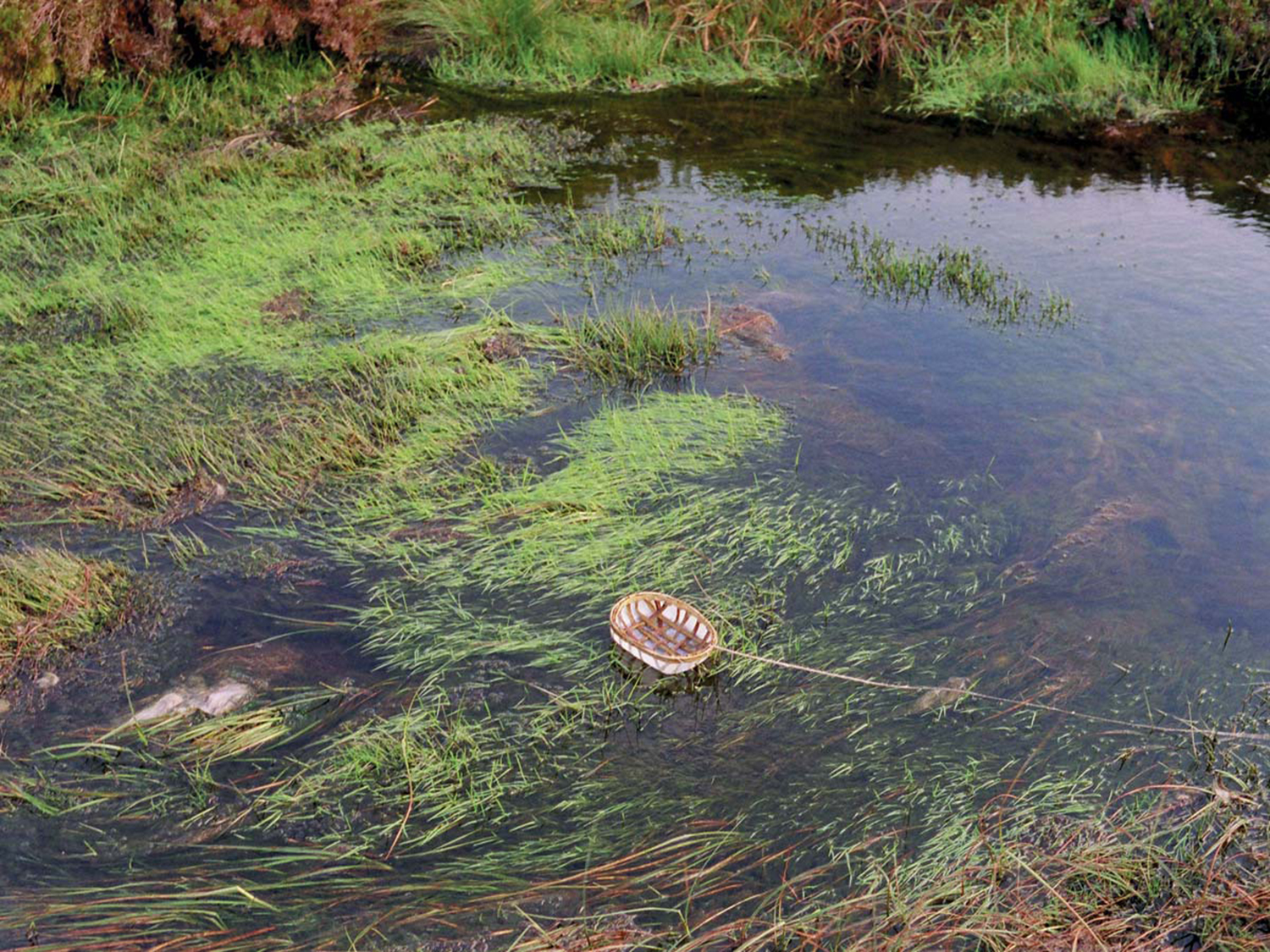forty-nine coracles with messages, 2004
Forty-nine miniature coracles with printed messages were created and floated down the River Severn as a means of exploring the river as an ecosystem with human interaction as a component part. Some of the coracles were made by young people from schools situated on the river who also walked near the source and along the river in Newtown.
Coracles were chosen for their ingenious and low-impact use of local materials. Coracles made from ash, cloth and tar were historically used for transport and fishing on the River Severn. The miniature coracles were made from brambles gathered from Hafren Forest and the riverbank in Newtown. They were stitched with linen thread, covered with paper and waterproofed with linseed oil. They were thus completely biodegradable. Each coracle had text printed on its paper covering. The text was presented in the language of its source - mostly English, with a smattering of Welsh placenames throughout. Some of the text came out of an investigation of the river through walks, interviews, books and the internet and other words were contributed by young people.
Our environment is increasingly ‘read’ and interpreted through text. A substantial part of this exploration of the River Severn was derived from printed and on-screen text. The coracles incorporated textual messages about the river for others to read. They were first exhibited at Oriel Davies Gallery in Newtown and then launched in the river for others to find downstream.
The project took place with the collaboration of Oriel Davies, Cywaith Cymru/Artworks Wales (with the financial assistance of the Arts Council of Wales) and with the sponsorship of Forestry Commission Wales.
pedwar deg naw o gwryglau gyda negeseuon
Cafodd pedwar deg naw o gwryglau bychain gyda negeseuon wedi eu hargraffu arnynt eu creu a'u harnofio i lawr afon Hafren fel dull o ymchwilio i'r afon fel ecosystem gyda rhyngweithio dynol fel rhan ohoni. Gwnaed rhai o'r cwryglau gan bobl ifanc o ysgolion a leolwyd ar yr afon a fu hefyd yn cerdded yn ymyl y tarddle ac ar hyd yr afon yn y Drenewydd.
Dewisiwyd cwryglau oherwydd y modd gwych yr oeddent yn defnyddio deunyddiau lleol, a hynny heb gael effeithiau ar yr amgylchedd. Defnyddid cwryglau wedi eu gwneud o ynn, brethyn a thar yn hanesyddol ar gyfer cludiant a physgota ar Afon Hafren. Gwnaed y cwryglau bychain o fieri a gasglwyd o Goedwig Hafren a glan yr afon yn y Drenewydd. Cawsant eu pwytho gydag edau llin, eu gorchuddio gyda phapur a'u gwneud yn ddiddos gydag olew had llin. Roeddent felly yn gwbl bydradwy. Roedd gan bob cwrwgl destun wedi ei argraffu ar y gorchudd o bapur. Cyflwynwyd y testun yn iaith ei ffynhonnell - Saesneg yn bennaf gydag ychydig o enwau lleoedd Cymraeg drwy'r cyfan. Daeth rhywfaint o'r testun allan o ymchwiliad i'r afon drwy deithiau cerdded, cyfweliadau, llyfrau a'r rhyngrwyd a chyfranwyd geiriau eraill gan bobl ifanc.
Mae ein hamgylchedd yn cael ei 'ddarllen' a'i ddehongli yn fwyfwy drwy destun. Deilliodd rhan sylweddol o'r ymchwiliad hwn o afon Hafren o destun wedi ei argraffu a thestun ar sgrîn. Roedd y cwryglau yn cynnwys negeseuon testunol am yr afon i eraill eu darllen. Fe'u dangoswyd am y tro cyntaf yn Oriel Davies Gallery yn y Drenewydd ac yna cawsant eu lansio yn yr afon i eraill eu darganfod yn nes i lawr.
Cynhaliwyd y prosiect gyda chydweithrediad Oriel Davies, Cywaith Cymru/Artworks Wales (gyda chymorth ariannol Cyngor Celfyddydau Cymru), a chyda nawdd Comisiwn Coedwigaeth Cymru.

